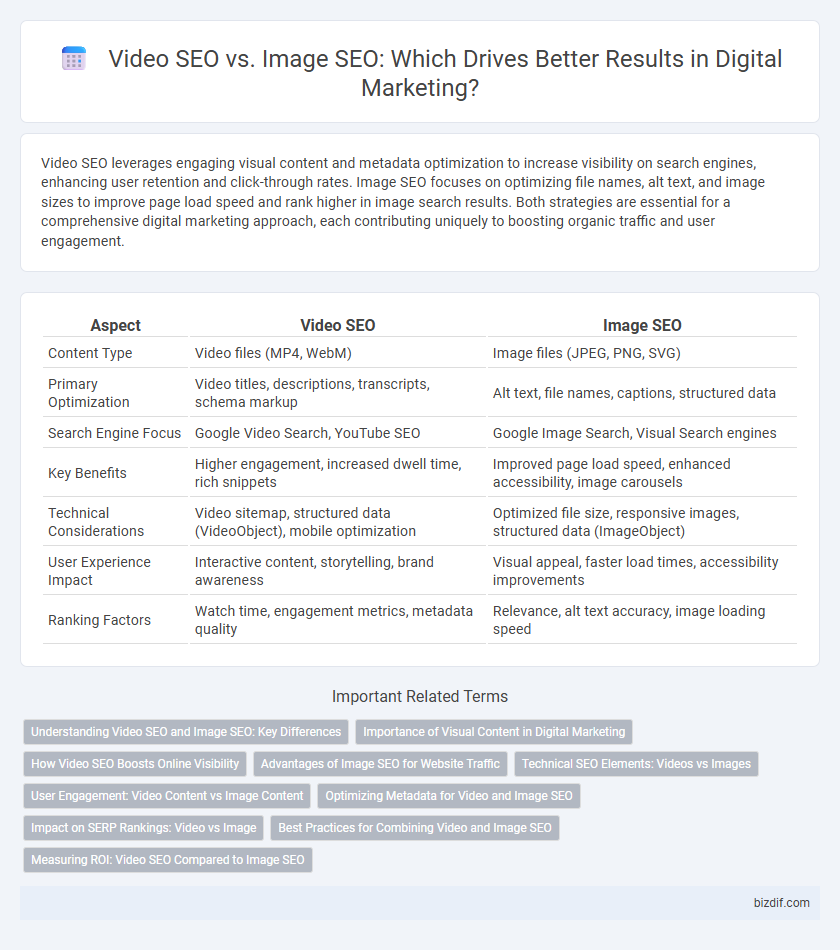Video SEO leverages engaging visual content and metadata optimization to increase visibility on search engines, enhancing user retention and click-through rates. Image SEO focuses on optimizing file names, alt text, and image sizes to improve page load speed and rank higher in image search results. Both strategies are essential for a comprehensive digital marketing approach, each contributing uniquely to boosting organic traffic and user engagement.
Table of Comparison
| Aspect | Video SEO | Image SEO |
|---|---|---|
| Content Type | Video files (MP4, WebM) | Image files (JPEG, PNG, SVG) |
| Primary Optimization | Video titles, descriptions, transcripts, schema markup | Alt text, file names, captions, structured data |
| Search Engine Focus | Google Video Search, YouTube SEO | Google Image Search, Visual Search engines |
| Key Benefits | Higher engagement, increased dwell time, rich snippets | Improved page load speed, enhanced accessibility, image carousels |
| Technical Considerations | Video sitemap, structured data (VideoObject), mobile optimization | Optimized file size, responsive images, structured data (ImageObject) |
| User Experience Impact | Interactive content, storytelling, brand awareness | Visual appeal, faster load times, accessibility improvements |
| Ranking Factors | Watch time, engagement metrics, metadata quality | Relevance, alt text accuracy, image loading speed |
Understanding Video SEO and Image SEO: Key Differences
Video SEO optimizes multimedia content by enhancing video titles, descriptions, transcripts, and schema markup to improve search engine rankings and user engagement. Image SEO focuses on alt text, file names, image dimensions, and compression for faster loading and better visibility in image search results. Key differences include video SEO's emphasis on user interaction metrics and detailed metadata, while image SEO prioritizes visual quality and accessibility for effective search indexing.
Importance of Visual Content in Digital Marketing
Visual content plays a crucial role in digital marketing by enhancing user engagement and improving search engine rankings through effective Video SEO and Image SEO strategies. Video SEO optimizes video elements such as titles, descriptions, and transcripts to increase visibility on platforms like YouTube and Google, driving higher organic traffic and longer site visits. Image SEO improves website performance by optimizing image file names, alt attributes, and loading speeds, which boost search engine indexing and user experience.
How Video SEO Boosts Online Visibility
Video SEO enhances online visibility by increasing engagement through dynamic content that captures user attention and extends site dwell time. Optimizing video metadata, transcripts, and thumbnails improves search engine ranking by making content more accessible and relevant to search queries. Compared to Image SEO, Video SEO leverages multimedia elements that cater to diverse user preferences and boost click-through rates on SERPs.
Advantages of Image SEO for Website Traffic
Image SEO enhances website traffic by improving visual content discoverability through optimized file names, alt text, and structured data, which boost search engine rankings. High-quality images increase user engagement and reduce bounce rates, contributing to better overall site performance. Additionally, image optimization accelerates page load times, positively influencing mobile user experience and search visibility.
Technical SEO Elements: Videos vs Images
Video SEO and Image SEO both require optimizing technical SEO elements, such as file size, loading speed, and structured data markup, to enhance search engine visibility. Videos benefit from transcripts, video sitemaps, and proper schema implementation, while images require alt text, descriptive filenames, and optimized formats like WebP for faster loading. Properly leveraging these technical elements improves indexing, user experience, and ranking for multimedia content in digital marketing strategies.
User Engagement: Video Content vs Image Content
Video SEO drives higher user engagement by offering dynamic, interactive content that retains viewers longer and encourages shares and comments on platforms like YouTube and TikTok. Image SEO enhances engagement through visually appealing graphics and optimized alt text that improve accessibility and boost click-through rates on search engines such as Google Images. Both strategies increase traffic, but video content consistently outperforms images in average session duration and conversion rates.
Optimizing Metadata for Video and Image SEO
Optimizing metadata for Video SEO involves using detailed titles, descriptions, and tags that include relevant keywords to improve video discoverability on platforms like YouTube and Google Video search. For Image SEO, optimizing alt text, file names, and captions with targeted keywords enhances image indexing and visibility in image search results. Effective metadata optimization drives higher organic traffic by aligning multimedia content with user search intent and search engine algorithms.
Impact on SERP Rankings: Video vs Image
Video SEO significantly boosts SERP rankings by increasing user engagement metrics such as watch time and click-through rates, which search engines prioritize. Image SEO enhances visibility in universal search results and supports core web vitals by improving page load speed and accessibility through optimized alt text. Combining both strategies drives comprehensive organic traffic growth by targeting diverse search intents and multimedia content preferences.
Best Practices for Combining Video and Image SEO
Combining video SEO and image SEO maximizes digital marketing impact by optimizing video titles, descriptions, and transcripts alongside image alt text, filenames, and structured data. Leveraging video sitemaps and schema markup enhances search engine crawling and indexing for both media types, improving overall visibility. Prioritize mobile-friendly formats and fast-loading media to boost user engagement and reduce bounce rates, aligning with Google's Core Web Vitals for better rankings.
Measuring ROI: Video SEO Compared to Image SEO
Measuring ROI in Video SEO often yields higher engagement metrics and longer user retention compared to Image SEO, as videos typically drive more conversions and brand awareness. Video content's ability to boost search rankings and increase click-through rates contributes to a more substantial return on investment. In contrast, Image SEO generates moderate traffic improvements but generally produces lower direct conversion rates than video marketing strategies.
Video SEO vs Image SEO Infographic

 bizdif.com
bizdif.com